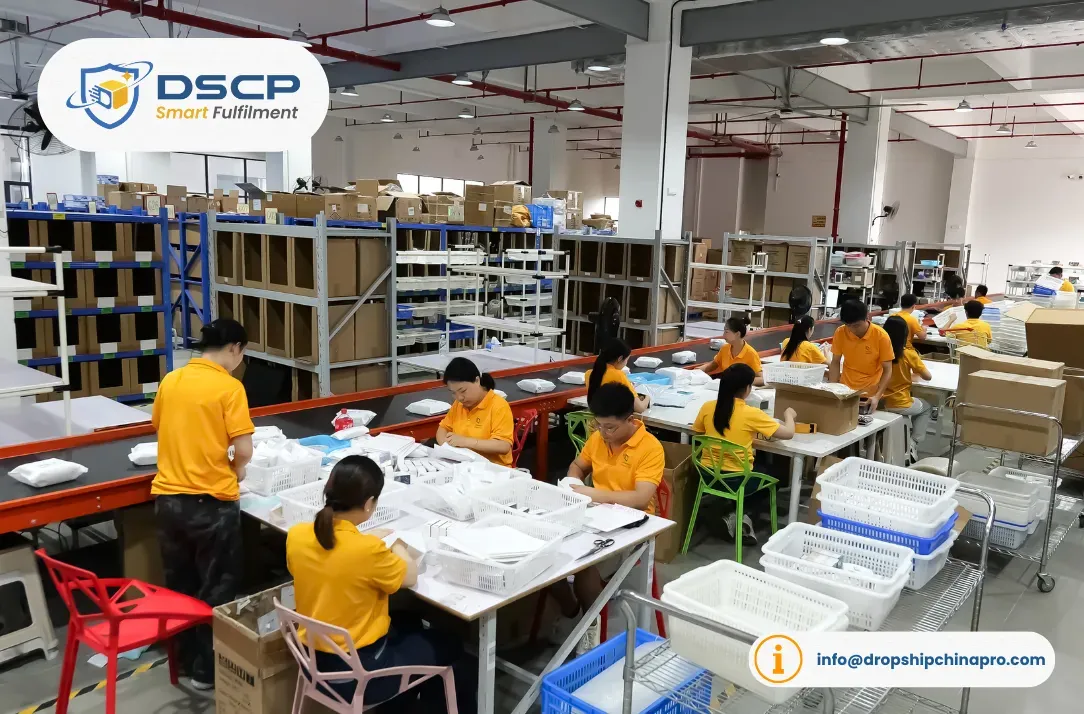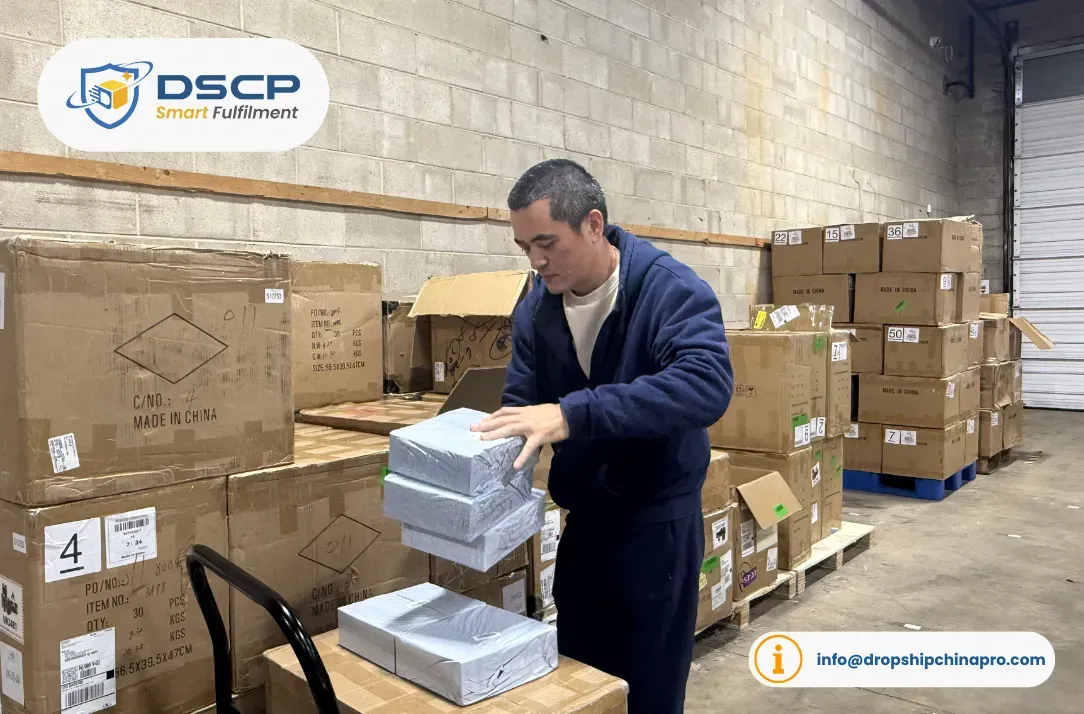Every online seller knows the problem: your customer orders a product today, and two weeks later, they’re still waiting. By the time the package arrives from overseas, they’ve either forgotten about the purchase or filed a chargeback. This shipping delay kills repeat business and damages your brand reputation. The solution isn’t complicated. Dropshipping suppliers in the USA are changing how e-commerce stores compete by delivering products in 2-5 days instead of 2-3 weeks.
According to recent logistics research, 88% of consumers consider fast delivery a key factor in their online shopping decisions (National Retail Federation, 2024). When your competitors are shipping from China, and you’re delivering from New Jersey or California, you win the customer.
This guide explains what US dropshipping suppliers actually do, how they work, and whether switching from international shipping makes sense for your business. You’ll learn about costs, warehouse locations, and practical steps to evaluate suppliers without the marketing fluff.

Key Takeaways: Dropshipping Supplier in the USA
- Fast delivery is now standard: 88% of consumers consider fast delivery a key factor in online shopping, making 2-5 day shipping from US warehouses a competitive necessity rather than a premium option.
- Hybrid fulfillment combines the best of both worlds: Sourcing products internationally while storing inventory in US warehouses delivers competitive pricing with domestic shipping speeds.
- Location determines speed and cost: Strategic warehouse positioning on both coasts provides 2-3 day ground shipping coverage for 90% of the US population while minimizing shipping expenses.
- US fulfillment costs more upfront but improves profitability: Expect 15-30% higher per-order costs compared to international shipping, but faster delivery increases conversion rates, reduces returns, and builds customer loyalty.
- Quality control matters as much as speed: The best US suppliers inspect products before they reach customers, preventing quality issues that damage your brand reputation and increase return rates.
- Not every business needs US fulfillment: The model works best for US-focused stores with decent margins, order volumes between 100-2,000 monthly, and customers who value fast shipping over rock-bottom prices.
What is a US Dropshipping Supplier?
A US dropshipping supplier stores inventory in American warehouses and ships products directly to your customers when orders come in. Unlike traditional international dropshipping, where products ship from China or other countries, these suppliers operate fulfillment centers on US soil.
The key difference is speed and reliability. While overseas suppliers might take 15-30 days to deliver, US-based operations typically ship within 24 hours and deliver in 2-5 business days using standard ground shipping.
Traditional Dropshipping vs. US-Based Fulfillment
Traditional dropshipping connects you directly to manufacturers or wholesalers in Asia. You pay less per unit, but shipping times are longer, and tracking is often unreliable. Your customers wait weeks, and you handle more support tickets about delayed orders.
US-based fulfillment changes the equation:
- Products ship from domestic warehouses
- Faster delivery builds customer trust
- Returns are simpler and cheaper to process
- You can offer expedited shipping options that actually make sense
The tradeoff is straightforward. US suppliers charge more per unit because of higher labor and facility costs. However, many sellers find that faster shipping increases conversion rates and repeat purchases enough to justify the higher cost.
Traditional vs US Dropshipping
| Feature | Traditional vs US-Based |
|---|---|
| Shipping Time | 15-30 days → 2-5 days |
| Product Cost | Lower → Higher |
| Return Processing | Complex → Simple |
| Customer Trust | Lower → Higher |
| Tracking Reliability | Inconsistent → Reliable |
Why US Dropshipping Suppliers Are Growing Fast
Customer expectations have shifted permanently. Amazon Prime trained an entire generation to expect 2-day delivery as standard, not premium service. When your store takes three weeks to deliver, customers assume something went wrong.
The numbers back this up. Research from the National Retail Federation shows that 71% of online shoppers expect delivery within three days or less (NRF, 2024). Miss that window, and you’re fighting an uphill battle for repeat business.
Three factors are driving sellers toward US dropshipping:
- Rising consumer expectations for delivery speed
- Increasing return rates on international shipments (customers won’t wait weeks to return a wrong item)
- Better profit margins from reduced customer service costs
The Real Cost of Slow Shipping
Slow shipping doesn’t just annoy customers. It hits your bottom line in multiple ways that don’t show up in your product cost calculations.
Cart abandonment increases when customers see long shipping estimates. Studies show that unexpected shipping times cause 22% of cart abandonments (Baymard Institute, 2024). You’re losing sales before customers even complete checkout.
Customer service burden grows with every “where is my order?” ticket. Tracking international packages takes time, and explanations about customs delays don’t satisfy frustrated buyers. Each support interaction costs money even when you’re not offering refunds.
Lost repeat customers hurt most. First-time buyers who wait three weeks rarely come back, even if the product quality is excellent. Fast shipping converts one-time buyers into loyal customers who order repeatedly.

How US Dropshipping Suppliers Work
Not all US suppliers operate the same way. Understanding the different models helps you choose the right fit for your business.
The Hybrid Fulfillment Model
The hybrid fulfillment model combines international sourcing with domestic warehousing. Suppliers import products from manufacturers in bulk, then store inventory in US warehouses. When your customer orders, the product ships domestically.
This approach offers the best of both worlds. You get competitive pricing from overseas manufacturing plus fast delivery from US facilities. The supplier handles customs clearance, import logistics, and quality control before products ever reach customers.
DSCP Smart Fulfillment operates on this model with warehouses in Pomona, California, and New Brunswick, New Jersey. Products are sourced from verified factories in China, undergo quality inspection, and are then shipped via ocean freight to US facilities, where they’re stored until orders arrive.
The process looks like this:
- You select products, and the supplier sources them from manufacturers
- Bulk shipments arrive at US warehouses after quality inspection
- Your customer orders through your online store
- The warehouse picks, packs, and ships within 24 hours
- Standard ground shipping delivers in 2-5 days
Traditional US Supplier Platforms
Platforms like Spocket, Zendrop, and Inventory Source connect sellers to networks of US-based suppliers. These marketplaces offer quick setup and product variety, but they come with limitations.
Product selection is typically narrower than international options. Pricing is higher because each supplier in the network maintains their own margins. You’re also competing with many other sellers offering identical products from the same catalog.
These platforms work well for testing products quickly or when you need an extremely simple setup. However, serious brands usually outgrow them and move toward dedicated fulfillment relationships where they have more control over quality, packaging, and customer experience.

Finding the Right US Dropshipping Supplier for Your Store
Choosing a fulfillment partner is a bigger decision than most sellers realize. The wrong choice means handling returns yourself, dealing with quality issues, or switching providers mid-growth (which is painful).
Key Features to Look For
Not every supplier who claims to be “US-based” actually is. Some simply have forwarding addresses while their inventory sits overseas. Look for these essential features:
- Actual warehouse facilities in the US with specific addresses you can verify
- Integration with your platform, whether that’s Shopify, WooCommerce, or custom systems
- Transparent pricing with no hidden fees for receiving, storage, or “account management”
- Quality control processes are documented and consistent
- Responsive support via phone and email, not just ticketing systems
The best suppliers also offer branded packaging options and the ability to include inserts or promotional materials. These small details separate professional brands from generic sellers.
Questions to Ask Before Partnering
Before committing to any supplier, get clear answers to operational questions that affect your daily business. Vague responses or reluctance to answer are red flags.
Ask these specific questions:
- What are your exact warehouse locations and coverage areas?
- How do you handle quality control on incoming inventory?
- What’s your average order processing time from receipt to shipment?
- Do you have minimum order quantities or monthly minimums?
- How do returns work, and what’s the inspection process?
- Can I speak directly with an account manager, or is support ticket-only?
- What happens during peak season when volume increases?
Document the answers. You’ll reference them later when comparing providers or if service quality drops after you sign up.
US Fulfillment Cost Breakdown
| Fee Type | Typical Cost Range |
|---|---|
| Storage (per cubic foot/month) | $0.50 – $2.00 |
| Pick & Pack (per order) | $2.00 – $6.00 |
| Receiving (per shipment) | $25 – $75 |
| Shipping (varies by zone) | Carrier rates apply |
US Dropshipping Supplier Pricing: What to Expect
Pricing for US fulfillment varies widely based on your order volume, product characteristics, and service level. Understanding the cost structure helps you calculate real margins and avoid surprises.
Most suppliers charge three main fee categories:
- Storage fees run approximately $0.50 to $2.00 per cubic foot monthly. Smaller, lighter products cost less to store. Large or heavy items increase your monthly bill even during slow sales periods.
- Pick and pack fees cover the labor of finding your product, packaging it, and preparing the shipment. Expect $2 to $6 per order, depending on complexity. Simple items like phone cases cost less than products requiring special packaging or assembly.
- Shipping costs follow standard carrier rates, but suppliers with high volume often secure discounts they pass along to clients. A package shipping from New Jersey to New York costs much less than shipping coast-to-coast, which is why warehouse location matters.
Additional fees to watch for include receiving charges when new inventory arrives, long-term storage premiums for products that sit unsold, and sometimes monthly minimums. Reputable suppliers disclose all fees upfront rather than surprising you on the first invoice.
Calculate your all-in cost per order, including product, storage, fulfillment, and shipping. Compare this to your current international shipping model. Many sellers find that US fulfillment costs 15-30% more per order but increases conversion and repeat purchase rates enough to improve overall profitability.
Shipping Speed Comparison
| Fulfillment Method | Delivery Time |
|---|---|
| China Direct Shipping | 15-25 business days |
| US Ground Shipping | 2-5 business days |
| US Expedited Shipping | 1-2 business days |
| International Air (Express) | 7-12 business days |
Shipping Speed Comparison: US vs. International
The speed difference between US dropshipping and international shipping directly impacts customer satisfaction scores and repeat purchase rates.
Standard international dropshipping from China or other Asian countries typically takes 15-25 business days. That’s 3-5 weeks from order to delivery. Faster international options exist, but they’re expensive enough that margins disappear for most products under $50.
US-based fulfillment delivers in 2-5 business days via ground shipping to most of the country. Expedited options can reach customers next-day or 2-day for reasonable fees since you’re not paying international air freight premiums.
The impact goes beyond just speed. Domestic shipping provides:
- Reliable tracking through familiar carriers like USPS, UPS, and FedEx
- Lower package loss rates compared to international shipments
- Simpler returns since customers ship back domestically
- Better customer service when issues arise
Think about it from your customer’s perspective. They order on Monday, receive tracking on Tuesday, and have the product by Friday. That experience builds trust that brings them back for repeat purchases. Three-week waits don’t.
Top US Warehouse Locations for Dropshipping
Where your inventory sits determines how quickly and cheaply you can reach customers. Smart warehouse positioning cuts costs while improving delivery speeds.
Why Location Matters
The United States spans multiple time zones and climate regions. A single warehouse location can’t serve everyone efficiently. Products shipping from California to New York take 5-6 days ground. From New Jersey to Los Angeles requires a similar time.
Two-warehouse strategies solve this problem. East Coast and West Coast facilities provide 2-3 day ground shipping coverage for roughly 90% of the US population. You’re also closer to major ports, which reduces costs when receiving international inventory shipments.
Strategic Warehouse Positioning
The most strategic fulfillment locations in the US cluster around major population centers and transportation hubs.
- East Coast operations typically center on New Jersey, Pennsylvania, or Georgia. New Jersey’s proximity to the Port of New York/New Jersey makes receiving international shipments efficient. The location also provides quick access to the Northeast megalopolis, where roughly 50 million people live.
- West Coast fulfillment concentrates in California, particularly around Los Angeles and the Inland Empire. Southern California warehouse space is abundant, close to the Port of Los Angeles (America’s busiest), and within 2-day ground shipping of the entire western US.
Businesses serving national customers benefit from both locations. You split inventory based on regional demand patterns, shipping each order from the closer facility. This approach maximizes speed while minimizing shipping costs.
Single-location strategies work when your customer base is regional. If 80% of orders go to customers in California, Nevada, and Arizona, a West Coast-only warehouse makes sense. East Coast-concentrated businesses benefit from New Jersey or Georgia facilities.

Is a US Dropshipping Supplier Right for Your Business?
Not every business benefits equally from switching to US-based dropshipping. The decision depends on your customer location, product margins, current shipping times, and growth stage.
Best Fit Scenarios
US fulfillment makes the most sense when these factors align:
- Your primary customers are in the United States
- Product margins support slightly higher fulfillment costs
- You’re getting customer complaints about shipping times
- Return rates are hurting profitability
- You want to offer expedited shipping options
Businesses in the 100-2,000 orders per month range often see the biggest impact. You’re large enough that fulfillment is consuming significant time, but not so large that you can justify building your own warehouse operation.
Premium and mid-range product positioning works better with US fulfillment than ultra-budget offerings. When customers pay $30-100+ for items, fast shipping feels appropriate and expected. Budget products under $15 may not support the economics.
When to Stick with Direct Shipping
International dropshipping still makes sense in specific situations. If you’re just testing products and validating demand, keeping costs low matters more than delivery speed. Launch with direct shipping, then upgrade to US fulfillment once you prove the product works.
Global customer bases also complicate US fulfillment. If you serve customers in Europe, Asia, and Australia, US warehousing only helps American orders. You’ll need either multiple regional warehouses or accept that some customers receive faster service than others.
Ultra-low-margin products sometimes can’t support US fulfillment economics. Products with $3-5 margins where every dollar matters may not work when fulfillment costs increase. Calculate carefully before switching. Further reading for proven dropshipping strategies in 2026.
Real-World Impact Metrics
| Metric | Before → After US Fulfillment |
|---|---|
| Average Delivery Time | 18-22 days → 3-4 days |
| Return Rate | 12% → 6% |
| Repeat Purchase Rate | 18% → 31% |
| Support Tickets (shipping) | Reduced by 65% |
| Per-Order Cost Increase | +$3.50 |
Real-World Example: From 3-Week Waits to 3-Day Delivery
A mid-sized home goods store was processing 400-600 orders monthly with products shipping directly from Guangzhou, China. Average delivery time was 18-22 days, and their return rate sat at 12% with most returns citing “took too long” as the reason.
After moving their top 15 products to the US warehouse storage (representing about 70% of order volume), the impact was measurable within 60 days:
- Average delivery time dropped to 3-4 days for domestic orders
- Return rate decreased to 6% as customers received products while still excited about the purchase
- Repeat purchase rate increased from 18% to 31% within three months
- Customer service tickets related to “where is my order” dropped by 65%
The per-order fulfillment cost increased by approximately $3.50 compared to direct China shipping. However, the store’s average order value was $65, and the improved customer experience led to a higher lifetime value that more than offset the fulfillment cost increase.
Their slower-moving products (30% of orders) still ship directly from China to keep costs manageable. This hybrid approach balanced economics with customer experience, letting them compete effectively in a market where fast shipping is expected. Further reading how US fulfillment warehouse speeds up delivery times.

FAQs for Dropshipping Supplier in the USA
Which supplier is best for dropshipping in the USA?
No single supplier works best for everyone. The right choice depends on your product type, order volume, and customer location. Look for suppliers with actual US warehouse facilities, transparent pricing, quality control processes, and integration with your e-commerce platform. Companies offering hybrid fulfillment models that combine international sourcing with US warehousing often provide the best balance of cost and speed.
How do I find a US dropshipping supplier?
Start by researching fulfillment companies with physical warehouse locations in the US. Check their website for specific facility addresses rather than vague “US-based” claims. Request pricing information and ask about their quality control processes. Most reputable suppliers offer consultation calls where you can ask questions about capabilities, technology integration, and service levels.
Is dropshipping profitable in the USA?
Yes, when managed correctly with realistic expectations. Profitability depends on product selection, supplier costs, marketing efficiency, and operational execution. US-based dropshipping typically has higher per-order costs than international shipping, but improves conversion rates and repeat purchases through faster delivery. Calculate your all-in costs, including product, fulfillment, shipping, and marketing, to determine if your margins work.
What’s the difference between 3PL and dropshipping suppliers?
Third-party logistics (3PL) companies store inventory you’ve purchased and fulfill orders on your behalf. You own the inventory and take financial risk if products don’t sell. Dropshipping suppliers own the inventory, and you only pay when customers order. Some companies offer both models. The hybrid approach lets you test products via dropshipping, then transition to 3PL when demand is proven, and you want better unit economics.
Can I dropship on Amazon?
Yes, but Amazon has specific requirements. You must identify yourself as the seller of record, ensure all packing slips and external packaging identify you as the seller, and be responsible for accepting returns. Many US dropshipping suppliers can accommodate Amazon’s requirements, including removing supplier branding and using your business information on all shipments. However, Amazon prohibits purchasing products from another online retailer and having that retailer ship directly to customers.
How do I start dropshipping with a US supplier?
Start by identifying your product niche and researching US suppliers who carry those products or can source them. Set up your e-commerce store on platforms like Shopify or WooCommerce. Contact suppliers to discuss pricing, minimum order requirements, and integration options. Most suppliers offer onboarding support to connect their systems with your store. Begin with a limited product selection to test the fulfillment process before expanding your catalog.
Is $500 enough to start dropshipping in the USA?
Starting with $500 is possible but tight. You’ll need funds for website setup ($50-200), initial product samples for quality verification ($100-200), and marketing to generate your first sales ($150-300). US dropshipping typically doesn’t require minimum inventory purchases since you only pay when customers order. However, budget for slower initial growth as you reinvest early profits. Most successful dropshippers recommend starting with $1,000-2,000 for a more comfortable cash flow.
What is the best store platform for dropshipping?
Shopify dominates US dropshipping due to its extensive app ecosystem and supplier integrations. Most fulfillment companies offer direct Shopify integration that automates order processing. WooCommerce (WordPress) provides more customization for tech-savvy sellers but requires more setup work. BigCommerce offers enterprise features for larger operations. Choose based on your technical comfort level, budget, and scalability needs. Most US suppliers integrate with all major platforms.

What E-Commerce Sellers Value in US Fulfillment Partners
When evaluating dropshipping suppliers in the USA, experienced sellers prioritize reliability and proactive problem-solving over just pricing. The difference between average and excellent fulfillment shows up in daily operations.
Parth Patel, who runs a growing e-commerce brand, emphasizes the importance of attention to detail: “I’ve worked with a few dropshipping agents in the past, and DSCP is by far the best one we’ve used. Their communication is excellent, and their attention to detail is even better.”
The proactive approach matters most when scaling operations. “They are great at identifying potential fulfillment problems before they occur and providing several solutions to resolve them,” Parth explains. This prevents issues from reaching customers rather than just reacting after complaints arrive.
Quality control extends beyond just shipping products correctly. “They offer competitive pricing and shipping times, and they are always helpful when it comes to creating custom products and improving quality. I’ve encountered situations where they have improved product quality directly with the factory after noticing recurring customer complaints.”
For sellers building serious brands rather than testing products, finding a fulfillment partner who acts as a quality control layer makes the difference between fighting constant customer service fires and focusing on growth. “I appreciate the proactive and straightforward approach,” Parth notes. That partnership mindset separates professional fulfillment services from basic shipping operations.
Make Shipping Speed Your Competitive Advantage
Your customers expect fast delivery. Your competitors are already adapting. Learn how US warehouse positioning and hybrid fulfillment can transform your delivery times from weeks to days without breaking your budget.
Contact our fulfillment team to discuss your specific requirements and warehouse strategy.
Conclusion
Choosing a dropshipping supplier in the USA isn’t just about faster shipping. It’s about building a sustainable business that customers trust enough to order from repeatedly. When your products arrive in days instead of weeks, you’re competing with professional brands rather than fighting the negative reputation traditional dropshipping carries.
The economics require careful evaluation. US fulfillment costs more per order than international shipping, but the complete picture includes fewer returns, reduced customer service costs, higher conversion rates, and better customer lifetime value. For most US-focused stores with decent margins, the math works in favor of domestic fulfillment.
References
- Baymard Institute. (2024). E-commerce Checkout Usability Study.
- National Retail Federation. (2024). Consumer View: Retail in 2024.

Hi, I’m Yavuz. I help e-commerce businesses grow through strategic content and SEO. Here, I share insights on fulfillment solutions, 3PL partnerships, and digital marketing strategies based on real data and industry trends.





